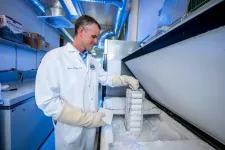Measuring the effects of radiotherapy on cancer may open up avenues for treatment
2021-05-27
(Press-News.org) Ionizing radiation is used for treating nearly half of all cancer patients. Radiotherapy works by damaging the DNA of cancer cells, and cells sustaining so much DNA damage that they cannot sufficiently repair it will soon cease to replicate and die. It's an effective strategy overall, and radiotherapy is a common frontline cancer treatment option. Unfortunately, many cancers have subsets of cells that are able to survive initial radiotherapeutic regimens by developing mechanisms that are able to repair the DNA damage. This often results in resistance to further radiation as cancerous growth recurs. But until recently, little was known about exactly what happens in the genomes of cancer cells following radiotherapy.
To probe the traits of post-radiotherapy cancer genomics, Jackson Laboratory (JAX) Professor Roel Verhaak, Ph.D., led a team that analyzed gliomas, a brain cancer, both when they first arose and after they recurred in 190 patients. They also looked at data from nearly 3,700 other post-treatment metastatic tumors. In "Radiotherapy is associated with a deletion signature that contributes to poor outcomes in cancer patients," published in Nature Genetics, the researchers present findings showing that radiotherapy is associated with consistent genomic damage in the form of a large number of DNA deletions. The study also implicates an error-prone DNA damage repair mechanism as being an important contributor to the deletion signature. Targeting this DNA repair mechanism may help maximize the efficacy of radiotherapy. The study was co-led by Floris Barthel, M.D., a senior fellow in the group, and first author Emre Kocakavuk, M.D., a visiting student from University Hospital Essen in Germany.
Analyzing the pre- and post-treatment glioma datasets as well as the post-treatment metastatic tumor dataset, Verhaak and his team identified a significant increase of small (five to 15 base pair) deletions and chromosome or chromosome-arm level deletions in response to radiation. Furthermore, the post-treatment small deletion pattern had distinct characteristics that implicate canonical non-homologous end joining (c-NHEJ) as the preferred repair pathway for radiation-induced DNA damage.
"c-NHEJ is an error-prone mechanism for DNA repair that cancer cells need to use to mitigate the damage done by radiation. We discovered that small deletions commonly happen as a consequence," says Verhaak.
The research also reveals that patients who acquire the high small deletion burden have significantly shorter survival than others post-radiotherapy. The finding implies that the deletion signature is associated with a loss of sensitivity to subsequent radiotherapy and suggests that the presence of many small deletions may serve as a biomarker for radiotherapy response. Somewhat paradoxically, tumors that acquire the high deletion burden signature appear to become robust, possessing sufficient, if not precise, DNA repair to survive mutation-inducing treatments. Therefore, even if initial radiotherapy is effective, recurrent tumors that exhibit this genomic trait are unlikely to respond to more.
On the other hand, the study supports the hypothesis that DNA repair inhibitors likely represent an effective therapeutic strategy and could improve cancer cell response to radiotherapy. At this point, research has indeed indicated that drugs known as PARP inhibitors are effective for treating various cancer types, and preliminary work is being done to evaluate other candidate DNA repair mechanism inhibitors.
"Finding a robust signature of c-NHEJ in post-irradiated tumors is very exciting because it suggests that slowing this repair process during radiotherapy could potentially increase the effectiveness of treatment," says Barthel.
INFORMATION:
ELSE PRESS RELEASES FROM THIS DATE:
2021-05-27
May 27, 2021 - Patients undergoing total hip arthroplasty (THA) show significant reduction in pain and other symptoms and improvement in walking gait biomechanics. However, those improvements do not lead to increased daily physical activity levels, reports a study in The Journal of Bone & Joint Surgery. The journal is published in the Lippincott portfolio in partnership with Wolters Kluwer.
The findings "present a worrying picture that while patients have the opportunity to be more physically active through improvements in functional capacity, their physical behaviors do not change," according to the new research, led by Jasvir S. Bahl of the University of South Australia, Adelaide, in collaboration with the University of Adelaide, Flinders University, ...
2021-05-27
In 29 new scientific papers, the Dark Energy Survey examines the largest-ever maps of galaxy distribution and shapes, extending more than 7 billion light-years across the Universe. The extraordinarily precise analysis, which includes data from the survey's first three years, contributes to the most powerful test of the current best model of the Universe, the standard cosmological model. However, hints remain from earlier DES data and other experiments that matter in the Universe today is a few percent less clumpy than predicted.
New results from the Dark Energy Survey (DES) use the largest-ever sample ...
2021-05-27
LA JOLLA, CA--Even before the COVID-19 pandemic, most people in the United States already had been sick with a coronavirus, albeit a far less dangerous one. That's because at least four coronaviruses in the same general family as SARS-CoV-2 cause the benign yet annoying illness known as the common cold.
In a new study that appears in Nature Communications, scientists from Scripps Research investigated how the immune system's previous exposure to cold-causing coronaviruses impact immune response to COVID-19. In doing so, they discovered one cross-reactive coronavirus antibody that's triggered during a COVID-19 infection.
The findings will help in the pursuit of a vaccine or antibody ...
2021-05-27
Although it is not spread through human contact, Francisella tularensis is one of the most infectious pathogenic bacteria known to science--so virulent, in fact, that it is considered a serious potential bioterrorist threat. It is thought that humans can contract respiratory tularemia, or rabbit fever--a rare and deadly disease--by inhaling as few as 10 airborne organisms.
Northern Arizona University professor David Wagner, director of the Pathogen and Microbiome Institute's (PMI) Biodefense and Disease Ecology Center, began a three-year project in 2018 to better understand the life cycle and behavior of F. tularensis, ...
2021-05-27
An estimated one in seven Ohio women of adult, reproductive age has visited a crisis pregnancy center, a new study has found.
In a survey of 2,529 women, almost 14% said they'd ever attended a center. The prevalence was more than twice as high among Black women and 1.6 times as high among those in the lowest socioeconomic group, found a research team from The Ohio State University. Their study appears in the journal Contraception.
Crisis pregnancy centers are often supported by religious organizations and are designed to discourage women with unintended pregnancies from choosing abortion, though they don't typically advertise themselves as anti-abortion. In Ohio, where more than 100 centers are spread throughout the state, they are funded by state dollars. In 2019, during ...
2021-05-27
Local management of coral reefs to ease environmental stressors, such as overfishing or pollution, could increase reefs' chances of recovery after devastating coral bleaching events caused by climate change, a new study finds. The results suggest that caring for reefs on a local scale might help them persist globally. When waters warm, corals can die quickly and en masse in coral bleaching events. Marine warming due to climate change has resulted in sharp increases in both the frequency and magnitude of these mass mortality events, which have already caused severe ...
2021-05-27
An exoskeleton can reduce the metabolic cost of walking not by adding energy or by recycling energy from one gait phase to another, as other exoskeletons have done, but by removing the kinetic energy of a striding person's swinging leg so they don't have to tense their muscles so much. Tested in ten healthy males, it also converted the extracted kinetic energy to useable electricity. Although humans are exceptional walkers, walking is metabolically expensive and requires more energy than any other activity of daily living. Exoskeletons and exosuits - wearable devices designed to work along with the body's musculoskeletal system - have been shown to reduce this cost by adding or recycling energy to assist the body's movement. These and other ...
2021-05-27
There is heightened public awareness that the world's oceans are under duress, with over-fishing and plastic pollution as some of the more tangible problems. Now, seabirds are calling attention to another problem and have delivered a warning message.
Serving as translators of the birds' message, an international team of 40 scientists led by William Sydeman at the Farallon Institute in northern California published findings on May 28 in the journal Science that some seabirds are struggling to raise young where the globe is most rapidly warming - in the northern hemisphere.
Using over 50 years of data from 67 seabird species across the globe, the team found ...
2021-05-27
In a study that uniquely evaluates marine ecosystem responses to a changing climate by hemisphere, researchers report that the fish-eating, surface-foraging bird species of the Northern Hemisphere suffered greater breeding productivity stresses over the last half-century than their Southern Hemisphere counterparts. The findings suggest the need for ocean management at hemispheric scales and underscore the importance of long-term seabird monitoring programs - some of which are already under threat - by illustrating the critical role that seabirds play as sentinels of global marine change. To date, global understanding of ocean change has not explicitly considered differences, ...
2021-05-27
Australian researchers recently reported a sharp decline in the abundance of coral along the Great Barrier Reef. Scientists are seeing similar declines in coral colonies throughout the world, including reefs off of Hawaii, the Florida Keys and in the Indo-Pacific region.
The widespread decline is fueled in part by climate-driven heat waves that are warming the world's oceans and leading to what's known as coral bleaching, the breakdown of the mutually beneficial relationship between corals and resident algae.
But other factors are contributing to the decline ...
LAST 30 PRESS RELEASES:
[Press-News.org] Measuring the effects of radiotherapy on cancer may open up avenues for treatment


